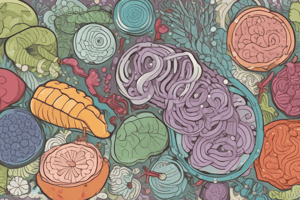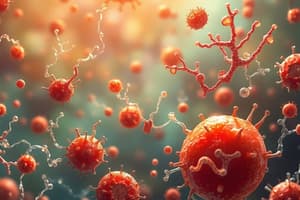Podcast
Questions and Answers
Which of the following microbial metabolic actions contributes least to the organoleptic spoilage of food products, focusing instead on the direct hazard it presents irrespective of sensory alteration?
Which of the following microbial metabolic actions contributes least to the organoleptic spoilage of food products, focusing instead on the direct hazard it presents irrespective of sensory alteration?
- Elaboration of mycotoxins by toxigenic molds in grains and nuts. (correct)
- Hydrolytic cleavage of triglycerides by microbial lipases, resulting in rancidity.
- Synthesis of diamines by decarboxylation of amino acids in fish, producing putrid odors.
- Production of volatile sulfur compounds leading to off-odors in protein-rich foods.
The phenomenon known as 'metabiosis' in the context of food spoilage invariably involves a single microbial species sequentially degrading a complex substrate into simpler compounds until complete mineralization occurs.
The phenomenon known as 'metabiosis' in the context of food spoilage invariably involves a single microbial species sequentially degrading a complex substrate into simpler compounds until complete mineralization occurs.
False (B)
Define 'hurdle technology' and propose a hypothetical combination of at least five distinct hurdles that, through synergistic effects, would ensure the long-term preservation of a minimally processed, ready-to-eat poultry product.
Define 'hurdle technology' and propose a hypothetical combination of at least five distinct hurdles that, through synergistic effects, would ensure the long-term preservation of a minimally processed, ready-to-eat poultry product.
Hurdle technology involves combining multiple preservation factors (hurdles) to inhibit microbial growth and maintain food quality. A hypothetical example: 1. Modified atmosphere packaging (MAP) with reduced oxygen and elevated carbon dioxide. 2. Inclusion of natural antimicrobials (e.g., bacteriocins). 3. A slight reduction in water activity (aw) through controlled drying. 4. Mild acidification (pH adjustment). 5. Refrigerated storage.
In the context of food fermentation, the sequential fermentation of malic acid to lactic acid by Oenococcus oeni during winemaking, known as ______ fermentation, serves to deacidify the wine and contribute to its overall microbial stability.
In the context of food fermentation, the sequential fermentation of malic acid to lactic acid by Oenococcus oeni during winemaking, known as ______ fermentation, serves to deacidify the wine and contribute to its overall microbial stability.
Match the following foodborne pathogens with their primary virulence mechanism contributing to pathogenesis:
Match the following foodborne pathogens with their primary virulence mechanism contributing to pathogenesis:
Given a scenario where a food product exhibits elevated levels of biogenic amines, which of the following enzymatic activities, primarily associated with microbial metabolism, would be most directly implicated in their formation?
Given a scenario where a food product exhibits elevated levels of biogenic amines, which of the following enzymatic activities, primarily associated with microbial metabolism, would be most directly implicated in their formation?
The presence of 'freezer burn' in frozen food products is solely attributable to the proliferation of psychrotolerant microorganisms actively metabolizing cellular components despite sub-zero temperatures.
The presence of 'freezer burn' in frozen food products is solely attributable to the proliferation of psychrotolerant microorganisms actively metabolizing cellular components despite sub-zero temperatures.
Delineate the critical differences in spoilage mechanisms between gram-positive and gram-negative bacteria in refrigerated, modified atmosphere-packaged (MAP) meat products, emphasizing the unique biochemical contributions of each group.
Delineate the critical differences in spoilage mechanisms between gram-positive and gram-negative bacteria in refrigerated, modified atmosphere-packaged (MAP) meat products, emphasizing the unique biochemical contributions of each group.
The phenomenon of 'swelling' in canned foods, indicative of microbial spoilage, is frequently caused by the production of ______ gas, often resulting from the anaerobic metabolism of carbohydrates by Clostridium species.
The phenomenon of 'swelling' in canned foods, indicative of microbial spoilage, is frequently caused by the production of ______ gas, often resulting from the anaerobic metabolism of carbohydrates by Clostridium species.
Match the following food preservation techniques with their primary mechanism of action:
Match the following food preservation techniques with their primary mechanism of action:
Considering the challenges associated with ensuring the safety of minimally processed foods, which of the following microbial inactivation strategies would be most effective in reducing the risk of Listeria monocytogenes contamination without compromising the food's sensory attributes and nutritional value?
Considering the challenges associated with ensuring the safety of minimally processed foods, which of the following microbial inactivation strategies would be most effective in reducing the risk of Listeria monocytogenes contamination without compromising the food's sensory attributes and nutritional value?
The presence of specific indicator microorganisms in food products invariably signifies the presence of pathogenic microorganisms capable of causing foodborne illness.
The presence of specific indicator microorganisms in food products invariably signifies the presence of pathogenic microorganisms capable of causing foodborne illness.
Describe the fundamental differences in biofilm formation between Pseudomonas aeruginosa and Listeria monocytogenes on stainless steel surfaces in a food processing environment, focusing on the exopolysaccharides (EPS) involved and the implications for sanitation protocols.
Describe the fundamental differences in biofilm formation between Pseudomonas aeruginosa and Listeria monocytogenes on stainless steel surfaces in a food processing environment, focusing on the exopolysaccharides (EPS) involved and the implications for sanitation protocols.
The phenomenon of 'souring' in milk is predominantly attributed to the fermentation of ______ by lactic acid bacteria, resulting in a decrease in pH and subsequent protein coagulation.
The phenomenon of 'souring' in milk is predominantly attributed to the fermentation of ______ by lactic acid bacteria, resulting in a decrease in pH and subsequent protein coagulation.
Match the following 'Good Guy' microorganisms (used in food production) with their primary metabolic contribution:
Match the following 'Good Guy' microorganisms (used in food production) with their primary metabolic contribution:
When evaluating the efficacy of a novel antimicrobial packaging film incorporating nano-silver particles, which of the following methodologies would provide the most comprehensive assessment of its ability to prevent Listeria monocytogenes growth on the surface of sliced, ready-to-eat deli meats during extended refrigerated storage?
When evaluating the efficacy of a novel antimicrobial packaging film incorporating nano-silver particles, which of the following methodologies would provide the most comprehensive assessment of its ability to prevent Listeria monocytogenes growth on the surface of sliced, ready-to-eat deli meats during extended refrigerated storage?
The 'Maillard reaction' in food processing invariably results in undesirable browning and flavor deterioration, and therefore should always be minimized.
The 'Maillard reaction' in food processing invariably results in undesirable browning and flavor deterioration, and therefore should always be minimized.
Critically evaluate the potential impact of climate change-induced shifts in environmental temperature and humidity on the prevalence and geographic distribution of aflatoxin-producing Aspergillus species in major agricultural commodities.
Critically evaluate the potential impact of climate change-induced shifts in environmental temperature and humidity on the prevalence and geographic distribution of aflatoxin-producing Aspergillus species in major agricultural commodities.
In the context of beer production, the process of 'lagering' specifically refers to the extended cold storage and maturation of beer fermented with ______ yeasts, resulting in a smoother flavor profile.
In the context of beer production, the process of 'lagering' specifically refers to the extended cold storage and maturation of beer fermented with ______ yeasts, resulting in a smoother flavor profile.
Match the following foodborne illnesses with their primary causative agent and the key foods/vehicles associated with outbreaks:
Match the following foodborne illnesses with their primary causative agent and the key foods/vehicles associated with outbreaks:
Considering the complex interactions within a cheese rind microbial ecosystem, which of the following strategies would be most effective in selectively promoting the growth of Brevibacterium linens while suppressing the growth of undesirable mold species, thereby positively influencing flavor development and rind appearance?
Considering the complex interactions within a cheese rind microbial ecosystem, which of the following strategies would be most effective in selectively promoting the growth of Brevibacterium linens while suppressing the growth of undesirable mold species, thereby positively influencing flavor development and rind appearance?
The application of high hydrostatic pressure (HHP) to food products invariably results in complete sterilization, eliminating the need for any subsequent refrigeration or other preservation methods.
The application of high hydrostatic pressure (HHP) to food products invariably results in complete sterilization, eliminating the need for any subsequent refrigeration or other preservation methods.
Propose a comprehensive strategy for mitigating the risk of viral contamination in fresh produce destined for raw consumption, integrating pre-harvest agricultural practices, post-harvest handling, and consumer education.
Propose a comprehensive strategy for mitigating the risk of viral contamination in fresh produce destined for raw consumption, integrating pre-harvest agricultural practices, post-harvest handling, and consumer education.
In the context of food safety risk assessment, the concept of 'D-value' specifically refers to the time required at a given temperature to reduce the population of a specific microorganism by ______ log cycle(s).
In the context of food safety risk assessment, the concept of 'D-value' specifically refers to the time required at a given temperature to reduce the population of a specific microorganism by ______ log cycle(s).
Match the following intrinsic and extrinsic factors affecting microbial growth in foods with their specific impact on microbial physiology:
Match the following intrinsic and extrinsic factors affecting microbial growth in foods with their specific impact on microbial physiology:
Considering the challenges of controlling fungal spoilage in stored grains, which of the following preservation strategies would be most effective in simultaneously inhibiting mold growth and preventing mycotoxin production while preserving the nutritional quality of the grain?
Considering the challenges of controlling fungal spoilage in stored grains, which of the following preservation strategies would be most effective in simultaneously inhibiting mold growth and preventing mycotoxin production while preserving the nutritional quality of the grain?
The presence of biofilms on food-contact surfaces invariably leads to direct food contamination with planktonic cells, posing an immediate public health threat.
The presence of biofilms on food-contact surfaces invariably leads to direct food contamination with planktonic cells, posing an immediate public health threat.
Elaborate a comprehensive strategy for verifying the effectiveness of cleaning and sanitization protocols in a food processing facility, incorporating both culture-dependent and culture-independent methods to ensure thorough removal of microorganisms and organic residues.
Elaborate a comprehensive strategy for verifying the effectiveness of cleaning and sanitization protocols in a food processing facility, incorporating both culture-dependent and culture-independent methods to ensure thorough removal of microorganisms and organic residues.
The process of 'nixtamalization,' traditionally used in the preparation of corn, involves treating the kernels with an alkaline solution of ______, which enhances the nutritional value of the corn and reduces mycotoxin contamination.
The process of 'nixtamalization,' traditionally used in the preparation of corn, involves treating the kernels with an alkaline solution of ______, which enhances the nutritional value of the corn and reduces mycotoxin contamination.
Match the following spoilage-related enzymatic activities with their corresponding effects on food quality:
Match the following spoilage-related enzymatic activities with their corresponding effects on food quality:
When assessing the potential for cross-contamination in a ready-to-eat food processing environment, which of the following sampling strategies would provide the most representative data regarding the prevalence of Listeria monocytogenes on food-contact surfaces?
When assessing the potential for cross-contamination in a ready-to-eat food processing environment, which of the following sampling strategies would provide the most representative data regarding the prevalence of Listeria monocytogenes on food-contact surfaces?
The effectiveness of pulsed electric fields (PEF) technology for microbial inactivation is independent of factors such as food matrix conductivity, microbial species, and treatment temperature.
The effectiveness of pulsed electric fields (PEF) technology for microbial inactivation is independent of factors such as food matrix conductivity, microbial species, and treatment temperature.
Describe the molecular mechanisms underlying the synergistic antimicrobial effects observed when combining nisin, a bacteriocin produced by Lactococcus lactis, with ethylenediaminetetraacetic acid (EDTA) in inhibiting the growth of Escherichia coli in a complex food matrix.
Describe the molecular mechanisms underlying the synergistic antimicrobial effects observed when combining nisin, a bacteriocin produced by Lactococcus lactis, with ethylenediaminetetraacetic acid (EDTA) in inhibiting the growth of Escherichia coli in a complex food matrix.
In the context of fermented foods, the term 'kefir grains' refers to a complex symbiotic community of bacteria and ______ embedded in a polysaccharide matrix, responsible for the fermentation of milk into kefir.
In the context of fermented foods, the term 'kefir grains' refers to a complex symbiotic community of bacteria and ______ embedded in a polysaccharide matrix, responsible for the fermentation of milk into kefir.
Match the following indicator microorganisms with their primary significance in assessing food safety and quality:
Match the following indicator microorganisms with their primary significance in assessing food safety and quality:
When designing a food safety management system based on Hazard Analysis and Critical Control Points (HACCP) principles for a ready-to-eat salad processing facility, which of the following steps would be considered the most critical in preventing Listeria monocytogenes contamination?
When designing a food safety management system based on Hazard Analysis and Critical Control Points (HACCP) principles for a ready-to-eat salad processing facility, which of the following steps would be considered the most critical in preventing Listeria monocytogenes contamination?
The presence of detectable levels of antibiotic residues in food products poses a negligible risk to human health, as these residues are typically present at concentrations far below therapeutic doses.
The presence of detectable levels of antibiotic residues in food products poses a negligible risk to human health, as these residues are typically present at concentrations far below therapeutic doses.
Describe the underlying principles and practical applications of quantitative microbial risk assessment (QMRA) in evaluating the public health impact of Salmonella contamination in poultry products, including the necessary data inputs and the interpretation of model outputs.
Describe the underlying principles and practical applications of quantitative microbial risk assessment (QMRA) in evaluating the public health impact of Salmonella contamination in poultry products, including the necessary data inputs and the interpretation of model outputs.
In the context of food irradiation, the unit of absorbed radiation dose is the ______, which represents the absorption of one joule of energy per kilogram of material.
In the context of food irradiation, the unit of absorbed radiation dose is the ______, which represents the absorption of one joule of energy per kilogram of material.
Flashcards
Food spoilage
Food spoilage
Spoilage is defined by undesirable changes in a food's appearance, texture, odor, or flavor, rendering it unacceptable.
Organic Acids in Spoilage
Organic Acids in Spoilage
Organic acids are produced by microbes during food spoilage, these acids contribute to sour and tart flavors.
Esters in Spoilage
Esters in Spoilage
Esters are flavor compounds produced by microbes during the spoilage of food.
Carbonyls in Spoilage
Carbonyls in Spoilage
Signup and view all the flashcards
Diamines in Spoilage
Diamines in Spoilage
Signup and view all the flashcards
Food Pathogens
Food Pathogens
Signup and view all the flashcards
Sources of Salmonella
Sources of Salmonella
Signup and view all the flashcards
Sources of Listeria
Sources of Listeria
Signup and view all the flashcards
Sources of Cyclospora
Sources of Cyclospora
Signup and view all the flashcards
Sources of Campylobacter
Sources of Campylobacter
Signup and view all the flashcards
Sources of E. coli
Sources of E. coli
Signup and view all the flashcards
Sources of C. botulinum
Sources of C. botulinum
Signup and view all the flashcards
Beer fermentation
Beer fermentation
Signup and view all the flashcards
Wine fermentation
Wine fermentation
Signup and view all the flashcards
Yogurt fermentation
Yogurt fermentation
Signup and view all the flashcards
Kefir Fermentation
Kefir Fermentation
Signup and view all the flashcards
Sauerkraut ingredients
Sauerkraut ingredients
Signup and view all the flashcards
Kimchi ingredients
Kimchi ingredients
Signup and view all the flashcards
Study Notes
- Microorganisms play significant roles in food, both desirable and undesirable.
Undesirable Microorganisms
- Food spoilage is a major cause of food waste.
- Spoilage refers to changes in a food's organoleptic properties.
- Microbes cause spoilage by growing on food and producing organic acids, esters, carbonyls, diamines, sulfur compounds, hydrocarbons, pigments
- Spoilage also causes visible colonies and changes in texture.
- Food pathogens are spoilage organisms that cause illness in humans
Specific Food Pathogens:
- Salmonella spp is found in vegetables, eggs, chicken, and pork and causes diarrhea, fever, stomach cramps, and vomiting
- Listeria monocytogenes is found in unpasteurized milk and dairy, deli meat, and raw fruits and vegetables; it may cause stiff neck, confusion, fever, or muscle aches, and can cause stillbirths in pregnant women if it spreads beyond the gut.
- Cyclospora is found in raspberries, basil, cilantro, snow peas and mesclun lettuce and causes diarrhea, loss of appetite, weight loss, stomach cramps/pain, bloating, increased gas, nausea, and fatigue, with symptoms appearing about one week post-infection.
- Campylobacter is found in unpasteurized milk, chicken, shellfish, turkey, and water; it causes diarrhea, cramps, fever, and vomiting.
- E. coli is contracted from contaminated food like undercooked beef, milk, raw fruits, and vegetables, leading to severe diarrhea and stomach pain.
- C. botulinum is found in improperly canned foods and honey in infants causing muscle weakness, blurred vision, and potential death.
Desirable Microorganisms
- Some fermented foods rely on microbial growth for preservation
Examples of Foods with useful Microorganisms:
- Beer
- Wine
- Yogurt (Lactobacillus bulgaricus and Streptococcus thermophilus, which are fermented using yogurt starter cultures)
- Kefir (Lactobacillus kefiri, Saccharomyces cerevisiae, and Saccharomyces unisporus, which are fermented using kefir grains in a symbiotic culture of bacteria and yeast)
- Vinegar (Acetic acid bacteria; Acetobacter),
- Sauerkraut (ferments longer than kimchi, is made primarily using cabbage, salt and caraway seeds, and is more tangy and sour)
- Kimchi (uses a wide variety of vegetables and spices, is fermented in a shorter time than sauerkraut, depending on the ingredients, and is spicy, salty and tangy)
Beer vs Wine
- Beer is brewed from grains and hops with flavors that range from light and crisp to dark and malty, similar to cooking in allowing addition of various ingredients and spices. It contains protein, fiber, B vitamins, folate and niacin, providing more nutritional value than wine. It is lower in alcohol content than wine but has the same amount of alcohol in a a standard glass of wine. It is generally cheaper, especially when comparing higher quality wines.
- Wine is made from fermented grapes and generally have a more acidic, fruity flavour that varies depending on the grape, aging and winemaking styles. Red wine in particular contains antioxidants such as flavonoids and tannins, which are believed to aid heart health. It has a higher alcohol content than beer and a pint has 50% more energy content than a glass of wine.
Desirable Microoganism Textures
- Yogurt contains thicker and more solid cultures
- Kefir contains thinner more liquid-like cultures
- Sauerkraut is typically shredded.
- Kimchi can be served in large chunks.
Studying That Suits You
Use AI to generate personalized quizzes and flashcards to suit your learning preferences.




